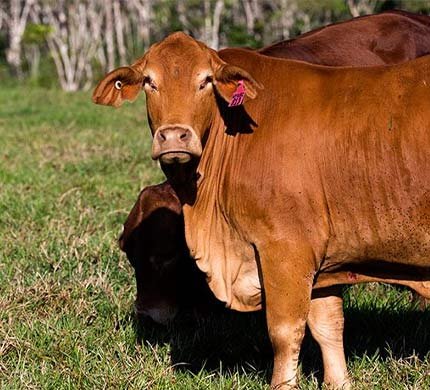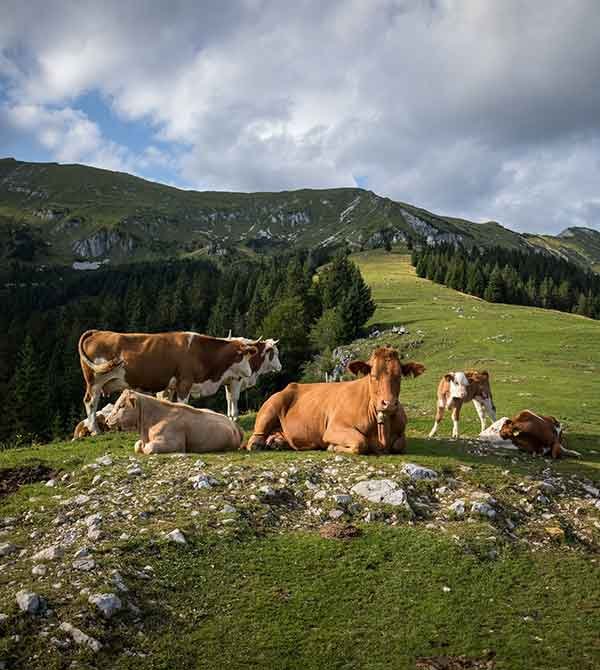Droughtmaster
- Temperature:Above 90°F (32°C)
- Milk:Around 5-10 liters of milk per day
- Food:Forages, legumes and browse
- Pregnancy:280 days or nine months
- Nationality:Australia

General Information
Droughtmaster is a breed of beef cattle that was developed in Australia in the mid-20th century. The breed was created by crossing several different British breeds, including the Brahman, Shorthorn and Hereford, to produce a hardy, adaptable and efficient beef animal that was well-suited to the Australian climate and terrain.
Droughtmaster cattle are known for their hardiness, adaptability, and heat tolerance, making them well-suited to hot and dry climates. They are also efficient converters of forage into meat, thanks to their ability to graze on a variety of different forages and their excellent feed conversion rates.
The breed is medium to large in size, with cows weighing around 450-550 kg (990-1210 lbs.) and bulls weighing around 700-900 kg (1540-1980 lbs.). They have a distinctive appearance, with a red or brown coat and white markings on the face and legs.
Droughtmaster cattle are primarily raised for beef production, and they are known for their excellent meat quality. The meat is flavorful, tender and well-marbled, making it popular with consumers.
Where we find this cow to buy?
Droughtmaster cattle are primarily raised in Australia, but they are also found in other countries with similar climates, such as parts of the United States and South Africa.
If you’re looking to buy Droughtmaster cattle, you can start by searching for breeders or ranchers in your area who specialize in this breed. Online directories, such as the Droughtmaster Australia website, can be a good resource for finding breeders and ranchers in your area.
It’s important to buy from a reputable breeder or rancher who has a history of producing healthy, high-quality animals. When selecting cattle, look for animals with good conformation, a healthy appearance and a calm temperament.
Before purchasing any cattle, it’s also important to consider the costs of raising and caring for them, as well as any regulations or requirements that may apply to owning livestock in your area. It’s a good idea to do your research and consult with experts in your area before making a purchase.

How to increase milk production in Droughtmaster
Droughtmaster cattle are primarily raised for beef production, so they are not typically used for dairy production. However, if you have a Droughtmaster cow that is producing milk, here are some tips on how to increase milk production:
01
Droughtmaster cows require a balanced diet that meets their energy, protein, and mineral requirements.
02
There are lactation boosters available that can help increase milk production in cows.
03
Milking your cow at the same time each day can help stimulate milk production and maintain consistent milk yields.
04
Using proper milking techniques, such as milking with clean hands and equipment, can help maintain cow health and milk quality.
05
Cow health is important for milk production, so monitor your cow’s health and address any issues promptly.
06
Cows require plenty of clean, fresh water to maintain milk production.
Medicine
Some common types of medicines used in cattle include:
01
AntibioticsUsed to treat bacterial infections such as pneumonia, mastitis, and foot rot.
02
AntiparasiticsUsed to treat and prevent internal and external parasites such as worms, lice, and ticks.
03
Anti-InflammatoriesUsed to reduce inflammation and pain associated with various health issues.
04
VaccinesUsed to prevent various diseases, such as respiratory and reproductive diseases.
Pregnancy
Provide adequate nutrition to support the developing calf and maintain the health of the cow. This includes feeding a balanced diet that meets the energy, protein and vitamin needs of the cow throughout pregnancy.
Proper management of breeding can help ensure a successful pregnancy. This includes ensuring that the cow is in good health and condition, and timing breeding to optimize conception rates.
Be prepared for the cow to give birth and provide a clean and safe environment for the calf. Ensure to provide support its growth.
Ensure that the cow is up-to-date on all necessary vaccinations to prevent disease and protect the health of the developing calf.
Important!
It’s important to work with a veterinarian who is knowledgeable about Droughtmaster cattle and can provide guidance and support throughout the pregnancy process.
Food
Droughtmaster cattle are adaptable to a wide range of environments and can thrive on a variety of forage types. The type of food that is best for your Droughtmaster cattle will depend on factors such as the age and stage of production of the animal, the availability of pasture or forage and the nutritional needs of the animal.
Droughtmaster cattle are well-suited to grazing and can thrive on a variety of forage types, including grasses, legumes, and browse. Provide access to high-quality pasture and forage throughout the year, and supplement with forage during times of scarcity.
Ensure that the diet contains adequate protein to support growth, reproduction, and milk production. Protein can be provided through legumes in pasture or forage, or through protein supplements such as soybean meal or cottonseed meal.
Provide a balanced mineral and vitamin supplement to ensure that the diet meets the animal’s nutritional needs. (Consult with a veterinarian first)
Monitor feed intake and adjust the diet as needed to ensure that the animal is receiving adequate nutrition for its age and stage of production.
Facts
Here are some interesting facts about Droughtmaster cattle:
They have a distinctive red or golden coat color, with white markings on the head and body, this unique feature set them apart.
Droughtmasters are a breed of cattle that were developed in Australia in the early 20th century to thrive in hot, dry climates.
Droughtmaster cattle are known for their excellent fertility, ease of calving, and ability to thrive on a wide range of forage types.
Droughtmasters are a versatile breed and are used for both beef and dairy production. They are also popular in rodeo events.
Droughtmasters have a long lifespan, with some cows living up to 20 years, which is a better than other common breeds.
The Droughtmaster Society, established in Australia in 1962, maintains a breed registry for this breed.